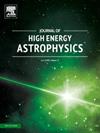Broadband spectral and emission geometry analysis of XB 1916–053 with Chandra and NuSTAR
IF 10.5
4区 物理与天体物理
Q1 ASTRONOMY & ASTROPHYSICS
引用次数: 0
Abstract
We report results from a broad-band spectral analysis of the dipping neutron star low-mass X-ray binary XB 1916–053 using the Chandra and Nuclear Spectroscopic Telescope Array (NuSTAR) observation. The spectrum can be well described with a combination of emission from a multi-colour disk (0.7 keV), a single-temperature blackbody (1.4 keV), and thermal Comptonization components (17 keV), with the neutron star surface (or boundary layer) serving as the primary source of Comptonizing seed photons. The timing and spectral properties suggest that the source is in a soft state, albeit with a relatively high electron corona temperature. Additionally, absorption features were detected in the persistent spectrum from the highly ionized Si, S, Ar, Ca, Fe and a blend of highly ionized Fe Kβ and Ni Kα transitions. These features suggest the presence of a highly ionized atmosphere above the accretion disk during persistent intervals. During the dipping intervals, the line of sight is obscured by the outer disk structure or bulge, which is denser and less ionized.
钱德拉和NuSTAR对xb1916 - 053的宽带光谱和发射几何分析
我们报告了利用钱德拉和核光谱望远镜阵列(NuSTAR)观测对倾斜中子星低质量x射线双星XB 1916-053进行宽带光谱分析的结果。光谱可以很好地描述为来自多色盘(kTin ~ 0.7 keV)、单温黑体(kTBB ~ 1.4 keV)和热合成组分(Γ ~ 1.9;kTe ~ 17 keV)的发射组合,中子星表面(或边界层)是合成种子光子的主要来源。时序和光谱性质表明,尽管电子日冕温度相对较高,但源处于软态。此外,在高电离的Si、S、Ar、Ca、Fe和高电离的Fe Kβ和Ni Kα混合跃迁的持久光谱中检测到吸收特征。这些特征表明,在持续的时间间隔内,吸积盘上方存在高度电离的大气。在倾斜间隔期间,视线被外层的盘结构或凸起所遮蔽,这些结构密度更大,电离程度更低。
本文章由计算机程序翻译,如有差异,请以英文原文为准。
求助全文
约1分钟内获得全文
求助全文
来源期刊

Journal of High Energy Astrophysics
Earth and Planetary Sciences-Space and Planetary Science
CiteScore
9.70
自引率
5.30%
发文量
38
审稿时长
65 days
期刊介绍:
The journal welcomes manuscripts on theoretical models, simulations, and observations of highly energetic astrophysical objects both in our Galaxy and beyond. Among those, black holes at all scales, neutron stars, pulsars and their nebula, binaries, novae and supernovae, their remnants, active galaxies, and clusters are just a few examples. The journal will consider research across the whole electromagnetic spectrum, as well as research using various messengers, such as gravitational waves or neutrinos. Effects of high-energy phenomena on cosmology and star-formation, results from dedicated surveys expanding the knowledge of extreme environments, and astrophysical implications of dark matter are also welcomed topics.
 求助内容:
求助内容: 应助结果提醒方式:
应助结果提醒方式:


